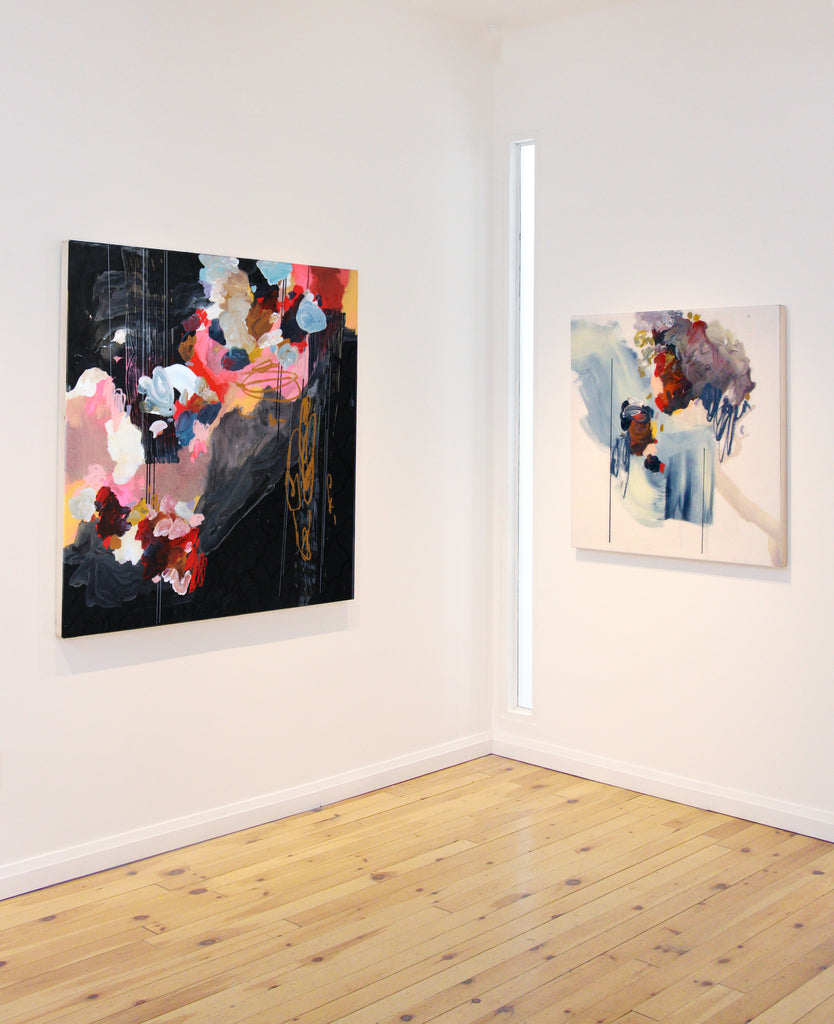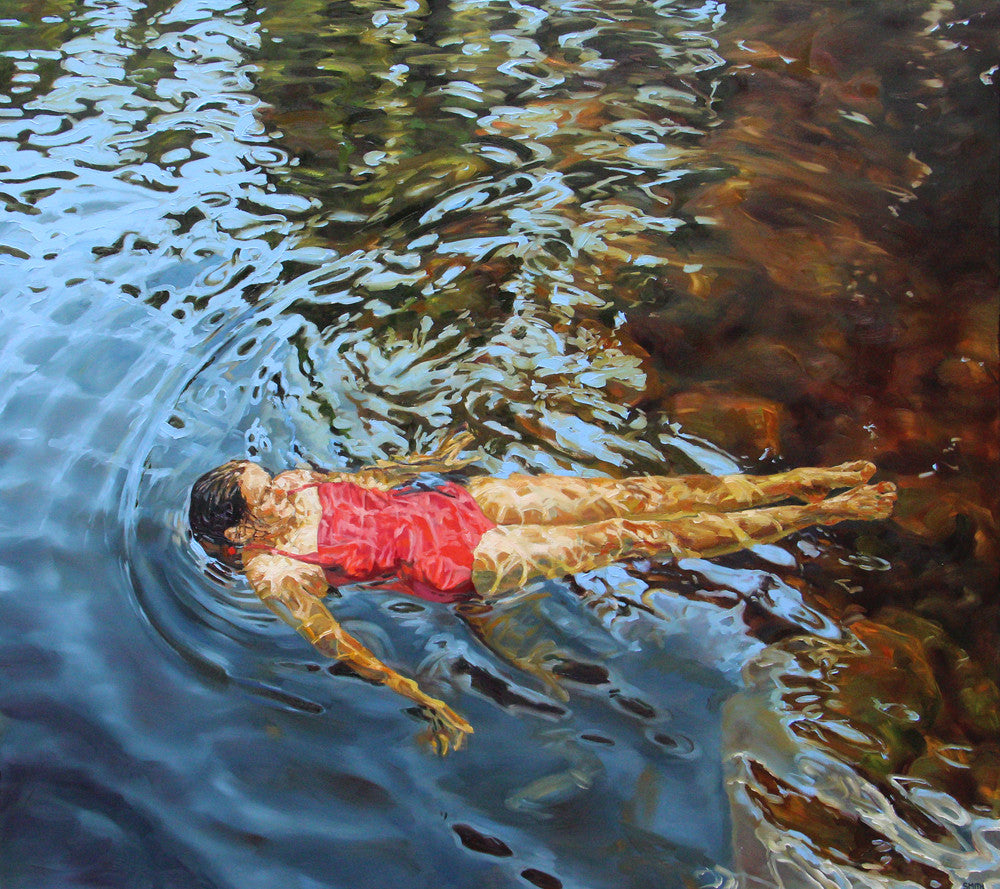
1) What would you like viewers to feel or experience when they look at one of your paintings ?
A deeper connection to the experience of conscious life
2) You suffered a serious stroke when you were a young adult and this experience has clearly re-defined and changed you as a painter. Could you elaborate ?
Painting wise I went from being a predominantly figurative painter who worked in acrylics and was heavily interested in the darker aspects of the human psyche, to landscape painting with a heavy interest in consciousness, meditation, wellness, pure/true pitch or sound in colour's relational pattern vibrations etc .. I'm less interested in creating personal (cathartic/therapeutic) psychological work, and more interested in tapping into a deeper collective connection and evolution and creating from this place (if possible).
3) How is this exhibition different from some of your other exhibitions that have preceded it ?
The work has become quite abstract. Fellow artist Val Nelson called it "celestial" and on the surface it kind of is.
I've really been interested in the similarities between patterns found in nature under a microscope and patterns found in the vastness of space. Macro and micro. And somehow trying to depict those so called "polarities" or perspectives, and creating movement between the two on each canvas. Instead of painting left/right or forward/aft movement, I'm trying to create more of a 4th or 5th dimensional experience. Kind of a lofty goal but it's really interesting to try.
4) What is the most indispensable item in your studio ?
My dogs
5) Is there a colour you deplore or simply cannot use ?
Phthalo blue & phthalo green
6) You have gradually moved from painting primarily on wood panels to painting primarily on canvas. Why ?
I was at Windsor Plywood one day talking to one of the guys I'd gotten to know there. We were talking about the doorskin I used to paint on and he told me it was cut from old growth forest. That didn't sit well with me. Painting trees on old growth forest felt like such a massive act of betrayal. Especially after being up in Haida Gwaii in 2004 and seeing some of the big logging trucks driving into the bush and coming out with one big tree, hundreds of years old, on their flat beds.
7) What is your creative process like ? Do you start many paintings at once or work on them individually one after the other ? Does your concept of a painting at the beginning look like the completed painting or is it often a surprise ?
I meditate a lot. Most of the work is done there. I just get out of the way, sit and listen and let my brain do the work it loves to do. Then when my mind is clear and can articulate its vision ( for lack of a better word, I live with Aphantasea and can't actually "envision" anything), through all the cells and nerves and structures of my body, I get to the laborious part of painting. Sometimes I start many paintings now and sometimes I work on one for a longer time. Sometimes it looks like how it did when it began, just more evolved, and sometimes it looks totally different.
8) Do you ever encounter creative blocks and if so how do you overcome them ?
I don't believe in "blocks." I think this is an inaccurate use of descriptive language and a way of describing something that is not fully understood. If you need water, you go to the source and get some water. I realise this is a first world analogy, but for the sake of this metaphor, the water is always there. If there are obstacles in the way of getting the water, is that a "block" ? When someone says they have a creative block, in my experience, they are imagining they are in a desert, waiting for it to rain when they could just get up and go turn on a tap, drive to a spring, walk to a well. This isn't the desert.
Do the work, there is no block.
9) Is there a particular artist or artists, living or dead, that has made an impact on you or your work ?
Several. Early on it was Van Gogh, Francis Bacon, Turner, Braque and Cezzane. Sam Messer, especially his series on Jon Serl ( One Man By Himself ). Etienne Zack has had a huge influence on me and my work even though we paint nothing alike. Julie Heffernan is a massive influence although her work is figurative and more literal/psychological. Many of the Lenningrad School of painters, I look through their work very often. And Johann Groebner who is now in Vienna. Jay Senetchko, Kim Kimbro Taylor. When I was in NY I studied a few of the Valesquez paintings there for hours. Emily Carr's work too. And AY Jackson. Christopher and Mary Pratt, too. Visiting with Christopher in his studio in Newfoundland was really incredible. Lawrence Paul Yuxweluptun, I have so much respect for that man. And my paternal grandmother and grandfather. My grandmother was a Sunday painter and my grandfather made exquisite pen and ink drawings. I'm interested in making a contribution to the history of painting and am conscious to learn as much as I can from other painters but take that learning and develop it into my own style of communication or connection.
Impact for me can come from looking at the work or knowing the person who is making the work. Most often it comes from both.
10) Are there upcoming projects or a series you are excited to explore ?
Many. I'm currently writing three books (a memoir, a book of recipes and a children's book), and continuation in developing ideas in painting.
11) Regardless of the subject matter in your work over the years, there is an overarching sense of movement, a shifting light, and a current of energy running through the paintings.Is this something you intentionally try to create in each work ?
To me, in paint or in life, what else is there really?
VIEW SHERI BAKES' COLLECTION OF WORKS HERE









